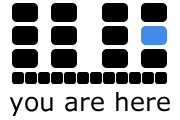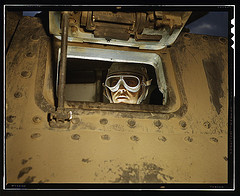Reading Metadata and the Rhetorical Situation
The application of metadata to an informatic object is an attempt to situate the object within a larger system—to position it in terms of an extant or emerging network. Metadata orients the reader’s attention toward the rhetorical situation of discourse, first defined by Lloyd Bitzer as the, “context of persons, events, objects, relationships, and an exigence which strongly invites utterance" (1968, p. 5). If, as Bitzer argues, effective rhetorical intervention hinges on the analysis of a situation, then how might we “read” metadata as indicators of a rhetorical situation? Or, more specifically, how does a “Standards in the Making” (SITM) approach to reading and composing metadata inform an analysis of a text’s reception, which Melody Bowden and J. Blake Scott assert, “involves analyzing the various factors that help shape [a text’s] use, from the material environment to the readers’ attitudes towards it” (2003, p. 5)?
The Flickr Commons project—a digital archive of the Library of Congress’ (LoC) collection of photographic images originally captured during the Great Depression and World War II—offers an excellent venue within which we may observe a community effort to fill gaps in the collection’s available record by analyzing and composing metadata (see Springer, M. et al., 2008). One of the images reproduced in the collection, “Tank Driver, Ft. Knox, Ky." (2008), is particularly interesting as an example of how metadata reflects the two sides of the binary Bowden and Scott establish between “material environment” and “reader’s attitudes,” quoted above. The metadata supplied by the LoC establishes some material context for the photograph: it was taken by Alfred T. Palmer in June 1942, archived as part of the U.S. Office of War Information collection in 1944, and depicts a soldier seated in a tank at the U.S. Army Armor Center at Ft. Knox. Keywords and LoC catalog numbers are also provided to facilitate search, retrieval, and citation of the image. This metadata provides clues to the image’s original rhetorical situation—the cultural, historical, and organizational contexts and exigencies that informed how the image was captured and archived. It also describes how the image has been resituated in different material contexts as it has become incorporated into various archives and reproduced in different forms such as the digital instantiation framed by the Commons.
As digital discourse technologies and the artifacts they frame have matured, mass digitization efforts such as The Commons seem to reflect a move to harness the affordances of both readymade standards that describe material conditions and SITM that reflect new, emergent, social schemas that encode “readers’ attitudes” toward a discourse object. The Commons can be imagined as a new social discourse space where arguments are mobilized through metadata itself. Such metadata can be read critically and, therefore, requires that the reader understand the rhetorical situation of metadata that is, itself, argumentative and not merely descriptive. The rhetorical situation of each instance of metadata, then, must be understood in order to reach a useful rhetorical analysis of the metadata as discourse.
Social metadata such as folksonomic tags, comments, and “notes” that are added within unregulated, “flat” metadata systems made up of emergent standards—such as those we find operating in The Commons—are patently rhetorical as opposed to simply descriptive. Users mobilize and engage arguments, support claims, and assert evaluative readings of a text (or, indeed, of other annotations to the text) through the metadata they apply to the image. Such metadata can be read critically and, therefore, requires that the reader understand the constantly changing rhetorical situation within which argumentative or evaluative metadata is deployed.
The metadata added by users takes three different forms on the Web page: comments added below the metadata provided by the LoC, “tags” listed in a sidebar, and “notes” which are layered over the image itself. Many of the tags (as Curtis, Matt, and Jentery all note) merely reproduce or modulate the existing metadata keywords (WWII, World War II, Palmer, Fort Knox, etc.) while others describe prominent features (goggles, tank, window, etc.), presumably, to facilitate serendipitous stumbling-upon or retrieval under different search schemes. Only one of these tags reflects a reader’s attitude toward the text: “too many notes,” a reference to the dense matrix of argumentative and evaluative notes layered over the original image.
These notes appear to be where the bulk of the community conversation is carried out through metadata annotations. Social, folksonomic metadata such as these are indicative of attitudes and orientations to the text and to the unfolding rhetorical situation as it is modified by subsequent annotations, many of which are directly conversant with one another, rather than the original photograph. Though there is no way of knowing the order in which each note was added (unlike the tags, which are listed chronologically, notes are arranged spatially), “clusters” of notes competing for space seem to reveal an ongoing discourse between users. For example, many of the notes point out features of the original image, particularly how the tanker’s “skull-like” appearance in the thumbnail version first attracted their attention. Successive users post their agreement (“At first glance I thought this was a skull! Wow, I can’t believe what a popular thought that was”—emmiepro) and elaborate with evaluative comments such as “creepy” and “eerie,” framing and revealing particular readings of the image. Other users attempt to “police” such annotations. In response to user fauxtography’s note “I wonder what this cloud is thinking right now,” user LiamCH replies: “retard. What the hell is wrong with you?” Such comments respond to exigencies external to the original image, exigencies created by the image’s re-situation as a digital artifact presented in an open, community space. As these annotations are layered on top of one another, competing for attention with each other and the original image, they respond less and less to the photo and instead focus on the emerging conversation that is framed within the same digital space as the image.
Such markup stands in stark contrast to other types of empirical metadata, such as geographic information system (GIS) and exchangeable image file format (EXIF) information appended to modern digital images. GIS metadata describes an instance of discourse’s “material environment” by locating it within space and time. While the application of GIS metadata can be rhetorically motivated—intended to connect discourse with an ongoing conversation—for the most part, it “tags” an instance of discourse with data that is essentially arhetorical. On its own, GIS metadata is descriptive rather than argumentative. This is especially true of instances where metadata is applied by machines, not added after the fact by humans, as we see in the comments section where self-appointed experts add information about the technical aspects of capturing such an image. EXIF data (the metadata that is automatically embedded in images by digital cameras that describes the technical aspects of image capture such as f-stop, aperture, and film speed, and also often includes GIS metadata) operates similarly, describing the conditions of image capture. EXIF and GIS metadata, however, seem to follow in the tradition of metadata that is empirical, disinterested, noncritical, and arhetorical. Metadata, in this sense, is applied with no implicit rhetorical strategy in mind; it is merely descriptive and indicative of the material environment of the rhetorical situation. Its ethos and logos are external to the rhetor, aligned more closely with the systems dictated broadly by content authorities than with any individual rhetor.
If we are to consider metadata to be a key concern of the new work of composing, then metadata must also be accounted for in the new work of reading, especially as digital remediation of analog artifacts open new venues for public deliberation and discourse where a textual artifact is never “closed” or “finished.” Folksonomic tags are part of the enduring digital “afterlife” of an analog object—a second order instantiation whose context arises from the comments and annotations of readers. In other words, folksonomic tags can be read as evidence of the emerging standards of an unfamiliar, readymade knowledge space. Projects such as The Commons transform marginalia into living discourse that shapes successive readings of a text, engender new exigencies, and require us to rethink exactly where the “margins” of a text are and how we account for fluid rhetorical situations that include the accumulating interventions of readers.

